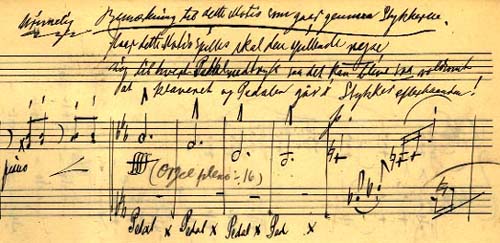Aspects & Points
Cryptography
Cryptograms are secret, hidden instructions or signs, and can of course be used in music. Schumann liked to include personal codes in his music, and another famous example is Elgar's Enigma Variations (1899).
Langgaard also made use of musical cryptography. The most obvious example is a gamut consisting of the four notes in a major seventh chord starting from the top and ending on the root, which appears in several of Langgaard's works. As a rule it is very heavily emphasised in the composition, so that there can be no doubt about its special importance, though the composer never directly refers to it.
In Symphony No. 11 these notes are played a number of times towards the end of the work by four tubas in unison and the piano. In the piano sonata, Le Béguinage, the motif appears in four of the five movements. In the 2nd Movement the central importance of this motif is made clear by Langgaard's - highly bizarre - commentary (see the reproduction below of this part of Langgaard's original manuscript): "Unreasonable footnote to this motif, which runs through the whole work. When this motif is played, the pianist should stand up to press the pedal, in such a way that the action is so violent that both piano and pedal end up by being damaged!".

As is the case here, the motif usually appears in the form of the notes of a B flat seventh chord. This must be interpreted as a personal symbol of fate, and a symbol of Judgement Day, probably a reference to the notes played by the bells of the Marmorkirken, such as Langgaard chose to interpret them. These notes can also be heard in the piano piece Hél-Sfærernes Musik (Music of the Hell-Spheres).
This sample of the score is reproduced by permission of Engstrøm & Sødring A/S.
![]()
![]()